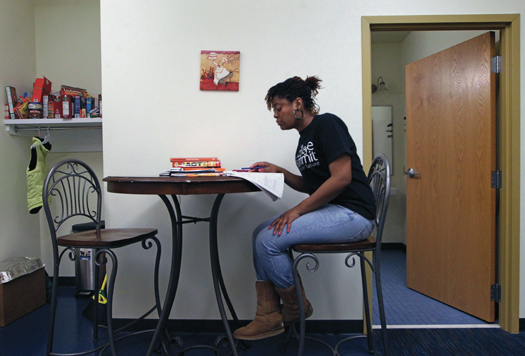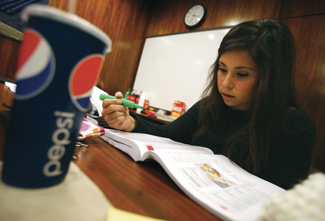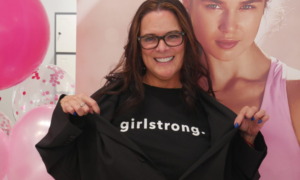
Mynecia Taylor, 18, studies for the ACT at her apartment on January 6, in St. Louis, Miss. Taylor opted out of foster care at the age of 18, losing some benefits she would have received until age 21. She would like to opt back in to get benefits available to college students, and legislation has been proposed to allow that. (Photo by Lauri Skrivan/St. Louis Post-Dispatch/MCT)
This summer, 26 foster youth going into 9th and 10th grade will spend four weeks living in dormitories at George Washington University as part of a year-long effort to expose them to — and prepare them for — college life. The students will take a two-credit college-level film reporting class and receive academic enrichment and remediation programs, said Teresa Zutter, director of First Star Greater Washington Academy, one of four Foster Youth Academies run by the national nonprofit First Star. Students will also participate in field trips, cultural events, a speakers’ forum and other activities designed to give them the enrichment and encouragement they need to ultimately be accepted into and graduate from two- and four-year college programs.
Young people who have experienced homelessness, have been in the foster care system, or have experienced other significant disruptions in their home or school lives may face significant barriers to getting into, and succeeding in, post-secondary education. A 2005 study by Casey Family Programs found that only 2 percent of young people who had been in foster care completed a bachelor’s degree. While there have been no studies of degree rates among young people who’ve experienced homelessness, a 2008 study by the Pell Institute found that only 12 percent of low-income young adults obtain bachelor’s degrees.
Greater Washington Academy is one of many programs across the country working to increase students’ access to higher education. Another is Seattle Education Access (SEA), serving low-income young people in King County, Washington. Eighty percent of the young people SEA works with have been homeless, have been in foster care, are young parents, or are immigrants, said Anthon Smith, SEA’s executive director.
Smith explained that for some students, perceptions and expectations are an issue: They haven’t received the same messages as children from middle- and upper-income families who have been raised assuming they will graduate high school and go on to college.
Disconnected students also face many practical barriers, said Smith. Homeless students, for example, may not have a safe, quiet place to study, or may not have access to a computer or printer to complete class assignments. The students Smith works with often have to juggle part- or full-time work schedules with class attendance, homework and, in some cases, care for their own children.

Bus passes or other transportation support are essential for students, said Smith, who added that these types of expenses aren’t usually included in a typical financial aid package.
Smith’s staff also works with young people on basic skills, like budgeting and building a resume, as well as helping them complete school and financial aid applications and other paperwork.
Smith said there are four elements students need to succeed in higher education: academics, finances, moral support and navigation. Adults working with young people need to determine: “What are the gaps for that student,” Smith said. “Is it just money, or is it information?” Academic and financial needs can be addressed with tutoring, loans and scholarships, but navigation may be the most essential service a youth-serving professional can provide, Smith suggested, because it is the element not necessarily provided by the school. Low-income students may not have people in their lives who have done these things before and can walk them through the process, he explained.
“For programs that are really interested in [focusing their resources on increasing access to higher education], it’s important to have a dedicated educational advocate,” said Smith, in addition to a case manager who can help with general life barriers like housing, child care or transportation. If your organization can’t support a dedicated staff member for educational issues, Smith suggested contacting the local college’s minority and diversity affairs office or other relevant entity (e.g., office of women’s or veterans’ issues). There’s often someone in that office who can help walk prospective students through the application process.
Young people also need role models who are like them (in ethnicity, socioeconomic background or life circumstances) who have gone to college. It doesn’t have to be an official mentoring relationship, said Smith, whose organization uses academic tutors to fill this role.
Youth workers can assist clients in navigating and overcoming some of the barriers to achieving higher education for nontraditional students (see sidebar for specific strategies), but it’s also important to put young adults in the driver’s seat, said Smith.
Support along the way is essential, but students need to learn from the process and become more independent over time. Adults can help young people find possible resources or solutions, Smith advised, but young people themselves need to be able to identify the barriers and ultimately take the steps necessary to solve them. That, after all, is what youth-development outcomes are all about.
Resources
• Seattle Education Access – For organizations looking to invest in or improve a college access program for nontraditional students, SEA has published a guide to replicating its work, available HERE.
• National Center for Homeless Education
• National Association for the Education of Homeless Children and Youth
Lower photo: Sylvia Agavo studies for her nutrition final during a Renaissance Scholars study session supervised by program coordinator Kizzy Lopez, not pictured, at Fresno State, Dec. 11, 2009, in Fresno, Calif. There are 33 students in the program that serves the needs of foster kids at the university. (Photo by Darrell Wong/Fresno Bee/MCT)































